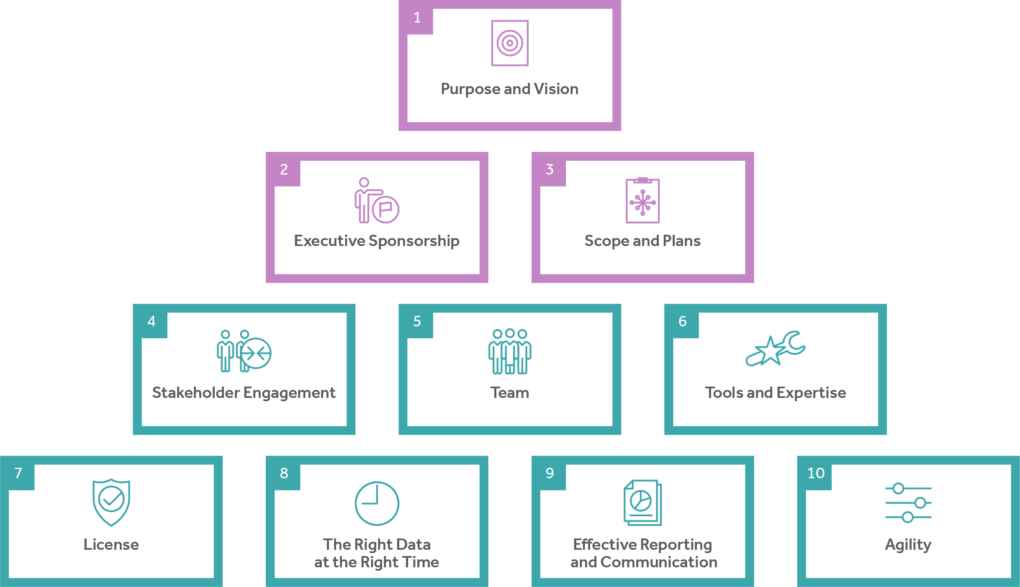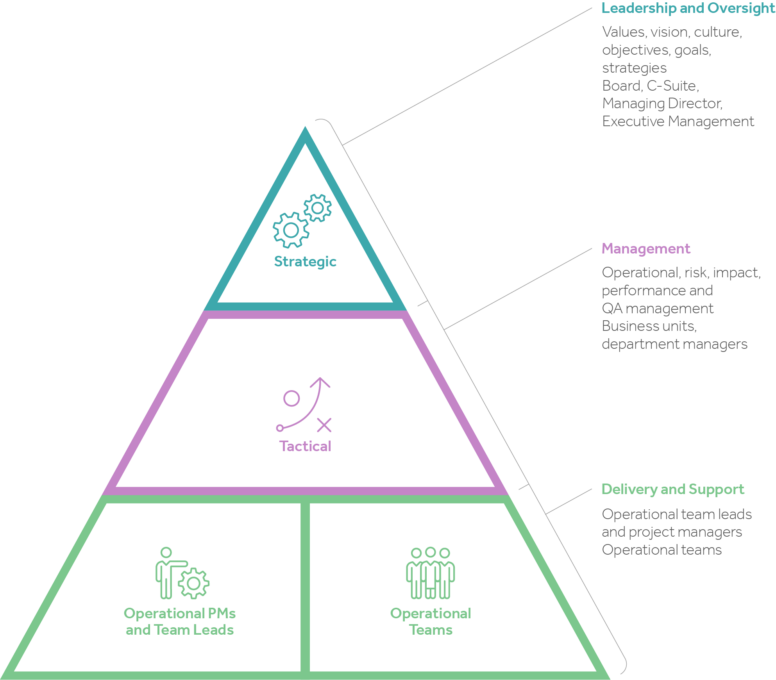
Have you ever wondered why some projects and programmes succeed while others fail miserably?
To the untrained eye, there may not be any noticeable differences between successful and unsuccessful projects when in fact there are some very real factors that can make or break projects, or indeed the hearts of those involved.
These are known as critical success factors or CSFs.
Critical success factors are tangible and intangible inputs and characteristics that must be in place if an enterprise’s sustainability transformation programme is to succeed. Success meaning the delivery of an enterprise’s sustainability transformation requirements on time and within budget.
Ten CSFs
While research into successful project delivery has identified ten CSFs that have a significant impact on project success rates1, our own delivery experience at RBESG yields a slightly different list that applies to the more typical all-encompassing transformational change programmes required for enterprise sustainability (Figure 1).

These are:
- Purpose and Vision
- Executive Sponsorship
- Scope and Plans
- Stakeholder Engagement
- Team
- Tools and Expertise
- License
- The Right Data at the Right Time
- Effective Reporting and Communication
- Agility
Within these ten CSFs, there are three strategic CSFs and seven tactical CSFs.
Strategic CSFs relate to goal setting, upfront planning and executive support whereas tactical CSFs relate to the tactical implementation of the goals and objectives set at the strategic planning stage.
Strategic CSFs also apply mainly to the strategic level of governance within an organisation while tactical CSFs rely on the efforts of those at the tactical and operational levels of governance (Figure 2).

Strategic CSFs
The three strategic CSFs for sustainability transformation are:
1. Purpose and Vision
Purpose and Vision requires the enterprise to align its sustainability transformation objectives to a clear purpose so that everyone knows what the enterprise is trying to achieve and why it is trying to achieve this. This helps enterprise individuals and teams connect intellectually and emotionally to the programme which in turn fosters a positive mindset of change within the organisation.
2. Executive Sponsorship
Probably the most fundamental CSF in our experience, Executive Sponsorship requires a senior individual in the organisation to actively and visibly champion and support the sustainability transformation programme (i) among leadership and management teams; (ii) to enterprise employees and workers and (iii) to all enterprise stakeholders.
Ideally this individual would be the most senior person in the organisation. If this can’t be facilitated for some reason, the executive sponsor must be an influential, senior figure with a seat at the top table and the ear of the highest governance body (HGB) and most senior individual(s) in the organisation.
3. Scope and Plans
As transformation programmes are typically major endeavours for organisations, it is imperative to clearly define both what the programme will deliver and what it will not deliver. Many programmes fall foul of scope creep or the need for major and costly change requests mid-programme as a result of misaligned expectations, so it is really important to ensure everyone is on the same page re scope before starting out. This is especially true when there are third parties involved as confusion or disagreement over scope can really damage relationships and trust. In addition, agreeing how items will be delivered and agreeing who is responsible and accountable for delivery upfront (RACI) will prevent potential conflict by setting expectations and ensuring buy-in for tasks.
Note: Scoping and planning a transformation programmes requires extensive engagement with affected teams and individuals so it is really important to ensure the PM is authorised and supported by the executive sponsor to engage the necessary individuals and groups as required.
Tactical CSFs
Continuing on from the three strategic CSFs, the seven tactical CSFs for sustainability transformation are:
- Stakeholder Engagement
- Team
- Tools and Expertise
- License
- The Right Data at the Right Time
- Effective Communication and Reporting
- Agility
4. Stakeholder Engagement
When businesses start on their sustainability journey, the concept of sustainability as the measure of company impact on people, human rights, the environment and the economy may not fully land with everyone initially. Enterprises are typically more used to considering how things affect their bottom line and are more familiar with a traditional set of primary stakeholders on whom the enterprise relies on for survival, such as financiers, shareholders, employees, suppliers, etc. When it comes to sustainability however, companies need to engage a far wider range of stakeholders who, although not necessarily imperative for company survival, may still be impacted/affected by the actions and decisions of the company. These could include local community members, the media and NGOs or civil society actors. Failure to engage with impacted stakeholders will impact delivery and more broadly may have a detrimental affect on the company’s social license to operate.
5. Team
The size and make-up of the enterprise’s team is another CSF for sustainability transformation. Many organisations, in the same way they confuse sustainability with climate change (i.e. they think only of GHG emissions), fail to grasp that sustainability as the measure of company impact, must encompass the whole enterprise, not just one or two departments or teams. This means the sustainability team must be sized to cope with the enterprise’s ambition in relation to its transformational scope and timing and it must be empowered to lead enterprise teams across the organisation through the required changes (see 2. Executive Sponsorship).
6. Tools and Expertise
The next CSF, Tools and Expertise, goes hand-in-hand with Team as having the right tools and appropriate expertise when needed is crucial for successful delivery. The right people know what needs to be done, when. More importantly they know how to do things or how to get things done. Having this know-how avoids a huge amount of stress and saves the enterprise a lot of time and money.
While not everyone on your team needs to be a sustainability guru, we recommend the Board, senior managers, sustainability lead and/or programme or project manager all have at the very least a foundational knowledge of sustainable development, responsible business conduct (RBC) and ESG reporting so that they can share this information as required among key personnel.
Note: All of these areas are covered in Section 2 in STS Plan. STS Plan also outlines the different roles and skills required for a sustainability transformation team.
In addition to expertise, having access to the right tools can be a key enabler to success. As sustainability impacts the entire organisation, the delivery team will need access to data in many/all of the enterprise’s management information systems and core applications. They may also need new tools to enable them record and manage data points and KPIs which are specific to the enterprise’s sustainability position. Ensuring the time and cost of obtaining access to existing systems or procuring new ones is factored into business cases, budgets and plans is vital to avoid unexpected cost or delay.
Note: STS Implement is a management information system specifically designed to support the data needs of companies who wish to report in accordance with the major international sustainability reporting standards and frameworks, such as the European Sustainability Reporting Standards (ESRS), the IFRS Sustainability Disclosure Standards, GRI Standards and TCFD.
7. License
License, in this context refers to the support or buy-in the enterprise receives from its stakeholders for its sustainability transformation. As enterprises are wholly dependent on their stakeholders for their success and survival, their ongoing license or support is vital. Enterprises are reliant on their stakeholders to inform them about how they are impacted by the enterprise and to provide feedback on what the enterprise needs to do to improve.
Failure to engage with or respond to stakeholders on their concerns may result in them withdrawing their support for the enterprise. Some may go further still, using their influence on social media platforms to connect to and mobilise a wider group of stakeholders to object if they perceive the enterprise or enterprise suppliers to be operating outside the bounds of expected ethical values and norms.
Enterprises all over the world are being ‘cancelled’ on a regular basis by stakeholders and members of the public who withdraw the enterprise’s social license to operate because of perceived or actual infringements or infractions of RBC obligations and norms so it is really important to engage stakeholders effectively to obtain their buy-in or license for the enterprise’s sustainability transformation programme.
8. The Right Data at the Right Time
From a sustainability transformation perspective, data is the glue that holds everything together. It provides all the control information required by the programme team to assess whether the programme is on track and provides all of the information required by stakeholders to assess the enterprise’s overall sustainability impact.
An enterprise’s sustainability or ESG report consists of a myriad of data points across all aspects of enterprise operation and impact that must be collated, analysed and responded to by the enterprise during the course of its sustainability transformation. Teams can quickly become overwhelmed with the amount of data involved if they are not rigorous in their identification of material or key data. That is why it’s important to plan upfront how impacts, risks, benefits, opportunities will be assessed and managed and to define the criteria that will be used determine and measure materiality and prioritise effort.
Finally, the enterprise must ensure it presents the right data to stakeholders. Presenting irrelevant or confusing data may frustrate stakeholders and lead to negative impact if stakeholders believe the enterprise is deliberately trying to obfuscate its position, greenwash or omit material information.
9. Effective Communication and Reporting
Like stakeholder engagement, effective reporting and communication is a cornerstone of successful transformation. From a reporting perspective, both internal and external reports are important. Internal reports enable the enterprise track it sustainability transformation programme delivery progress and cost together with all enterprise impacts, risks and opportunities, including ones the enterprise may not be comfortable or ready to disclose to third parties. While enterprise sustainability reports should be transparent and frank about enterprise impacts, risks and opportunities, the enterprise does need time to consider its response to these so its stakeholders can trust there is a plan in place to address adverse impact. While it is equally important for the enterprise not to omit key information, presenting a problem without a solution or a plan to get to a solution can lessen stakeholder confidence. This means there’s a balance to be struck.
Having a formal due diligence process in place where enterprise teams meet regularly to identify and assess impacts, risks and opportunities will help ensure the enterprise has time to fully assess its impact in advance of publishing the enterprise’s sustainability report.
In addition to formal reporting, ongoing communication among enterprise team members and key stakeholders will ensure everyone is kept abreast of progress and that everyone knows who should be doing what, when. This will avoid things falling between the cracks and contribute more generally to a harmonious programme and sustainability transformation experience.
10. Agility
The final critical success factor for sustainability transformation is agility. When we speak of agility, we don’t mean that the enterprise’s transformation programme needs to be delivered in an agile way. It is up to each enterprise to determine the programme delivery methodologies it wants to use. We mean the more quickly and easily the enterprise can react, pivot and reprioritise in response to impacts, events, conditions, influences and information, the more resilient it will be to shocks and the more effective it will be in realising its sustainability objectives.
The specific conditions for agility are not easily identified or articulated but involve finding the right balance between process and rigour and the need for out of the box thinking, flexibility, innovation and creativity. Enterprise agility will depend a lot on the attitude of the executive sponsor and senior management team and the level of autonomy and authority they imbue in the programme manager and programme team.
If failure is to be avoided at all costs in an organisation, the transformation team may be afraid to make necessary decisions when issues arise. Similarly, if the PM is given little to no authority to make decisions and must instead bring everything through a committee style process, the delivery team will lose the ability to achieve certain wins or deliver benefits. A sustainability lead who is empowered and trusted to lead and is sufficiently resourced can help ensure the enterprise responds in an agile, effective way to positive and negative sustainability impacts, risks and opportunities as they arise.
Conclusion
Sustainability transformation, like any enterprise-wide change programme is a major, complex undertaking and should thus not be taken lightly. On the other hand, it is at its core simply that, an enterprise change programme, for which many blueprints exist. While it may be the first time your organisation has transformed, many others have gone before you and lived to tell the tale. It is really worthwhile therefore to leverage this experience by ensuring the key critical success factors for sustainability transformation are in place before starting out. While these may not reduce your workload, they most certainly will smooth the path ahead and help set you up for longer-term success.
References:
1 Pinto and Slevin 1988, 1989, 1990; Pinto and Prescott 1988.






